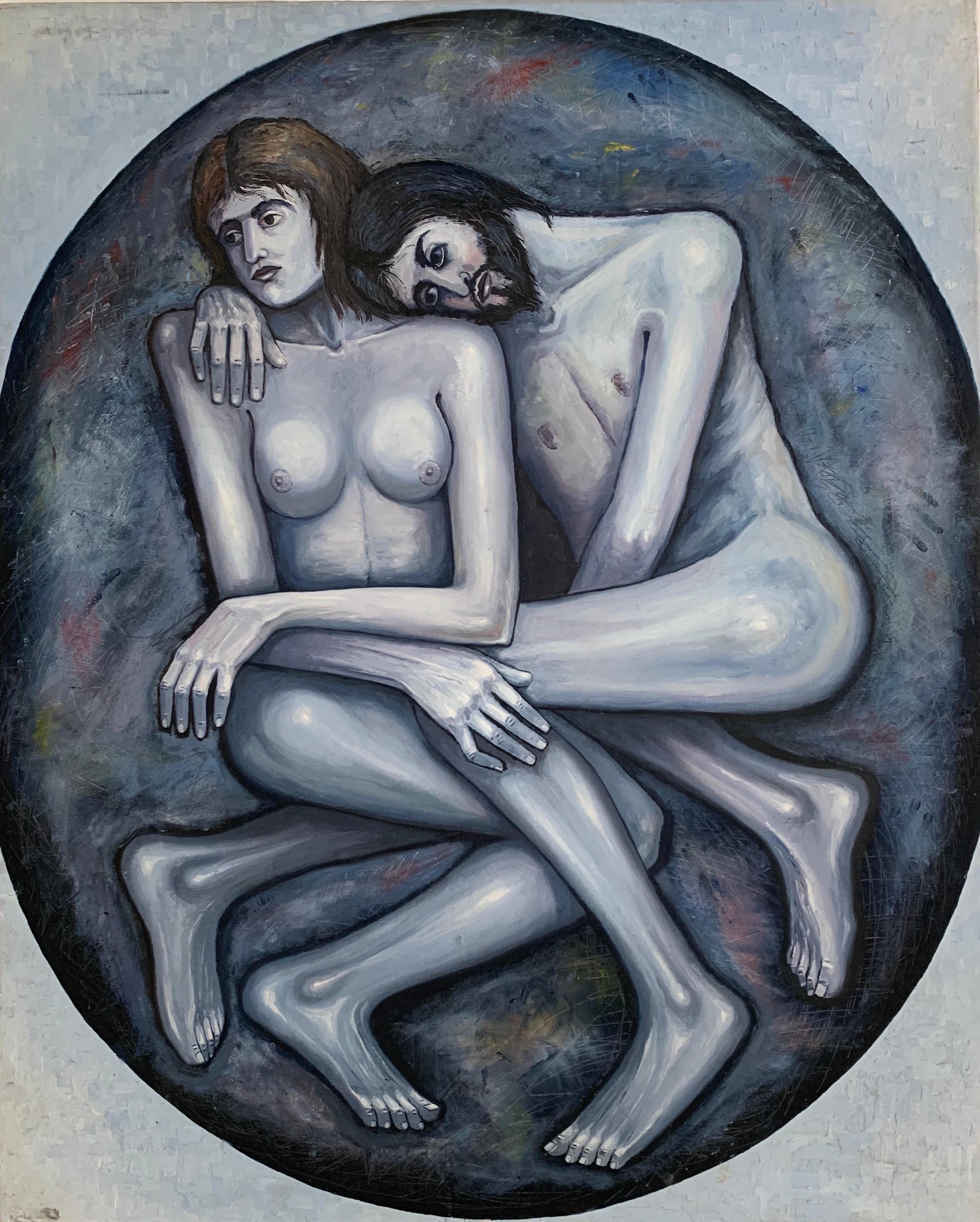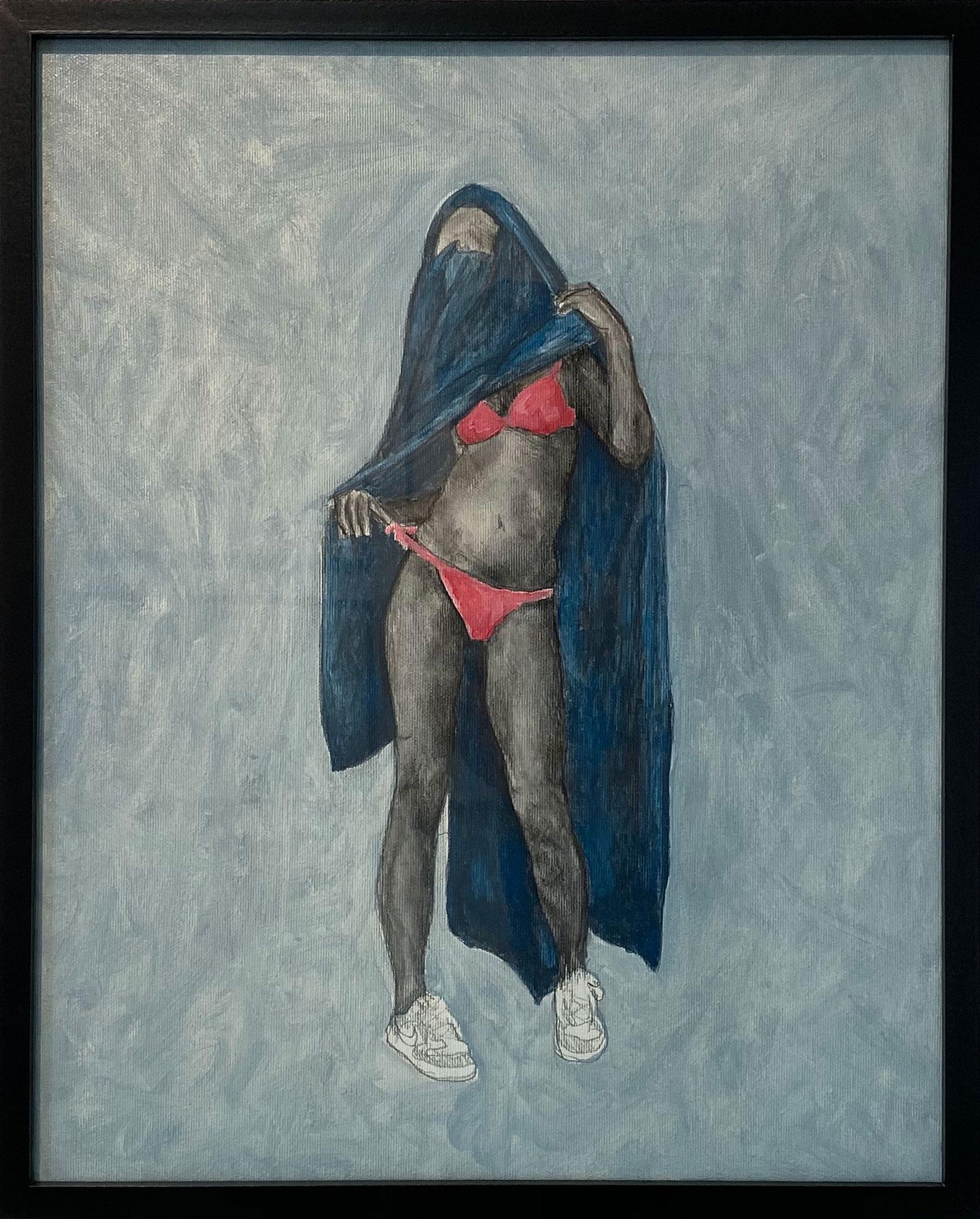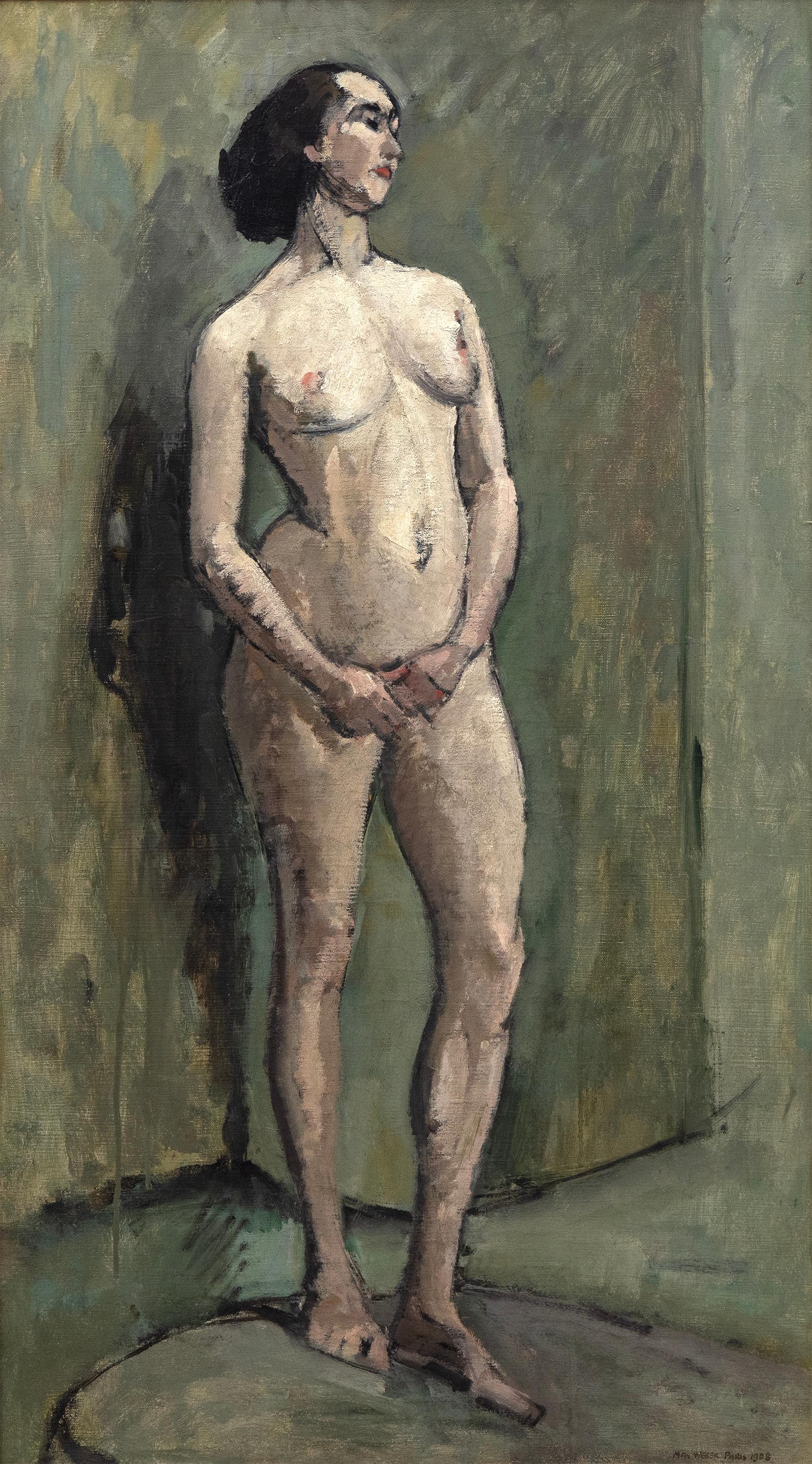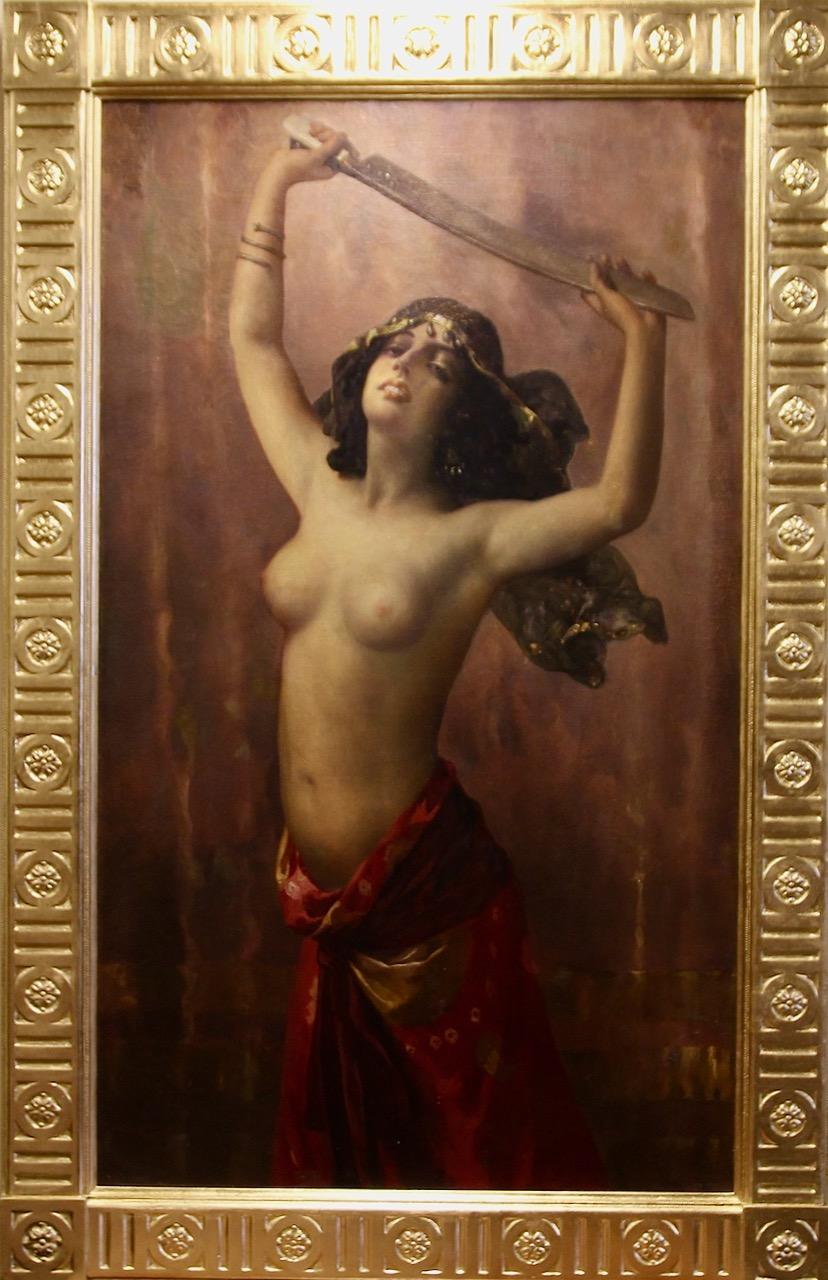Items Similar to Suicidio di Lucrezia dipinto di Giuseppe Marullo
Want more images or videos?
Request additional images or videos from the seller
1 of 17
Giuseppe Marullo (Orta di Atella 1615 - Naples 1685)Suicidio di Lucrezia dipinto di Giuseppe Marullo
About the Item
Giuseppe Marullo (Orta di Atella, 1610 ca – Napoli, 1685)
Suicidio di Lucrezia
Olio su tela, cm 132 x 94
Con cornice, cm 148 x 110
Pubblicato in “Achille della Ragione, Scritti di storia dell'arte, Edizioni Napoli Arte, Napoli, Maggio 2014, p.69".
Il dipinto raffigura Lucrezia mentre affonda il pugnale sotto al seno scoperto. Lucrezia fu matrona romana, resa nota soprattutto grazie ai racconti di Tito Livio, che narra di come ella sia stata prima minacciata e poi abusata da Sesto Tarquinio, vicenda che la portarono a togliersi la vita.
Nella posa di tre quarti, nel volto contrito dal dolore così come nella morbidezza dei passaggi chiaroscurali, seppur piuttosto contrastati, si ravvedono peculiarità pittoriche tipiche del clima culturale napoletano. Non mancano infatti i riferimenti ad Andrea Vaccaro – si vedano la Cleopatra al museo del Prado, Madrid e Lucrezia di Collezione Privata - così come a Massimo Stanzione. È in effetti proprio nel filone di quest’ultimo che si può rintracciare l’autore del dipinto in oggetto e in particolar modo al compaesano nonché allievo Giuseppe Marullo. È il biografo De Dominici a fornirci le poche informazioni pervenute sul Marullo e a includerlo tra gli scolari di Stanzione ed in una posizione di rilievo; infatti, alla morte del maestro, è proprio il Marullo a ricevere il testamento spirituale del caposcuola, la sua raccolta di disegni di pittori seicenteschi napoletani e parecchie notizie biografiche sugli stessi.
Il De Dominici lo dava nativo di Orta di Atella, senza specificare quando, e morto a Napoli nel 1685: è possibile stabilire i natali al primo decennio del XVII secolo, essendo la prima opera certa una pala firmata 1631 nella chiesa delle Pentite di Castrovillari, Calabria. Sopperisce a una carenza di documenti scritti l’abitudine da parte del Marullo di firmare, spesso in latino, e di datare le opere, così che si è potuto restituire – ma solo in tempi recenti e spesso grazie a interventi di restauro sui dipinti - al pittore le opere e conoscere il suo percorso evolutivo.
Infatti, per lungo tempo il Marullo è stata personalità poco indagata e riconosciuta dalla critica e ciò ha portato a confondere sovente le sue opere con quelle del suo maestro, come avvenuto per una Sant'Agata passata come opera dello Stanzione, ma riferibile invero al pennello di Marullo. La Sant’Agata mostra peraltro somiglianze con la Cleopatra di collezione Hoyos a Rosenburg, in Austria, restituita al Marullo dallo Schultze.
A lungo considerato dalla critica come imitatore dei modi stanzioneschi ma anche di Pacecco de Rosa, pittore che in effetti per un certo periodo gli fu ispiratore, il Marullo a uno sguardo più attento rivela invece una personalità autonoma capace di fondere e rivisitare i linguaggi della pittura napoletana intorno alla metà del Seicento. Quando era in vita la sua attività godette certamente di buona fama, come dimostrato dalla presenza di numerosi suoi quadri negli inventari delle più importanti famiglie napoletane dell'epoca, ma anche alcune commissioni pubbliche, purtroppo oggi scomparse, come il ciclo eseguito nel 1644, sia a tela sia a fresco, che il Marullo porta a compimento nella cupola e nella zona presbiteriale della chiesa di San Sebastiano. Nel 1646 si registra invece il saldo di pagamento per il completamento delle tele per il soffitto della Pietà dei Turchini. La produzione dell’artista, piuttosto prolifica, consta per lo più di opere a carattere religioso e destinante alle chiese partenopee e di provincia, pur non mancando temi allegorici e storici, di cui la presente è un esempio e che dimostra l’attenzione del pittore verso soggetti in voga all’epoca. Inoltre, tra il 1643 e il 1644 eseguì diversi dipinti per Domenico Mazzarotta, tra cui tre ritratti non rintracciati. De Dominici riferisce che ricevette da parte dell’ambasciatore spagnolo Pedro Antonio de Aragón, la commissione di dodici quadri, che portò a termine a Napoli, dove l’ambasciatore si trasferì da Roma nel 1666 per ricoprire la carica di viceré. Fra le opere musealizzate si cita La pesca Miracolosa, presso la pinacoteca del museo campano di Capua, firmata "Joseph Marullus" e considerata dalla critica tra le migliori opere dell'artista per la perfetta fusione di elementi culturali derivati dagli esempi dello Stanzione, e di efficaci soluzioni luministiche forse desunte dallo Stomer.
In Achille della ragione, Giuseppe Marullo Opera Completa, Edizioni Napoli Arte, Napoli, 2006 è stata condotta una ricognizione puntuale dell’artista e delle sue opere, a cui lo stesso autore restituisce la presente nel saggio Una scoperta e una riscoperta per Marullo, pubblicato in Achille della Ragione, Scritti di Storia dell’Art, Edizioni Napoli arte, Napoli, maggio 2014, p. 69.
- Creator:Giuseppe Marullo (Orta di Atella 1615 - Naples 1685) (1615 - 1685)
- Dimensions:Height: 51.97 in (132 cm)Width: 37.01 in (94 cm)Depth: 1.97 in (5 cm)
- Medium:
- Period:
- Condition:
- Gallery Location:Milan, IT
- Reference Number:1stDibs: LU2639214366192
About the Seller
No Reviews Yet
Vetted Seller
These experienced sellers undergo a comprehensive evaluation by our team of in-house experts.
1stDibs seller since 2023
- ShippingRetrieving quote...Ships From: Milan, Italy
- Return PolicyA return for this item may be initiated within 14 days of delivery.
More From This SellerView All
- Battle scene Oil painting on canvas Attributed to Karel BreydelBy Karel BreydelLocated in Milan, ITAttr. to Karel Breydel, known as the Knight of Antwerp (1678 - 1733) Battle with knights and landscape in the background Oil on canvas, cm 44.5 X 36.7 Frame 52.5 x 45 cm The pain...Category
Late 18th Century Figurative Paintings
MaterialsCanvas, Paint, Oil
- Pompeian scene with spinner Painted François-Barthélemy-Marius AbelLocated in Milan, ITFrançois-Barthélemy-Marius Abel (Marseille, 1832 - Paris, 1870) Scene with spinner Oil on canvas, 91 x 71 cm Framed, 120 x 100 cm Signed and dated "F. Barthelemy 1876" A young ...Category
19th Century Figurative Paintings
MaterialsCanvas, Paint, Oil
- Game of bowls Oil painting on canvas by Domenico OliveroLocated in Milan, ITDomenico Olivero (Turin, August 1, 1679 - January 13, 1755) Game of bowls Oil on canvas, 43 x 65 cm With frame, 54.5 x 76 Expert opinion Prof. Alberto Crispo The painting shown here depicts peasants playing bowls near a farmhouse, while one of them offers sweets to a little girl. The canvas, in my opinion, can be traced back to the hand of Pietro Domenico Olivero (Turin, August 1, 1679 - January 13, 1755), as revealed by comparisons with other works by the artist, such as the Peasants' Feast already at the Gilberto Zabert Gallery in Turin, where we find an entirely similar layout, with the figures crowded around the building, placed on the left, and some household goods piled up on the right, including a copper cauldron almost identical to the one sketched in our painting. But see also other similar subjects painted by the Turin-based artist, such as the Game of Bowls already at the Cantore Gallery in Modena or the other version on the Genoese market in 2019, which, although radically different compositionally, confirm the painter's interest in playful themes and manifest the same ways in delineating characters, with synthetic and robust brushstrokes. The artist was born in Turin, in the parish of St. Thomas, on August 1, 1679 to Giovanna and Francesco, a carver by profession. He trained at the workshop of the painter and architect Melchiorre Baldassarre Bianco. He was esteemed by Victor Amadeus II of Savoy, who commissioned paintings for the Venaria Reale (1714), the Royal Palace of Turin (1716), and Rivoli Castle (1724), as well as by his ministers Pietro Mellarède and Carlo Vincenzo Ferrero di Roasio marquis of Ormea whose collections counted many of the painter's works. His success on the Turin art scene earned him election as prior of the Accademia di San Luca in Turin (1726). In 1731 he painted the eleven canvases with Stories of Franciscan Saints in the sacristy of the church of St. Thomas in Turin, while in 1734 he made the Marriage at Cana for the sanctuary of Oropa. The Savoy commissions continued with the ten canvases executed for the castle of Agliè (1737), the decoration of the third room of the New Archives in the Royal Palace of Turin (1739-41), and the thirty or so works for the hunting lodge at Stupinigi (1748-51). The painter also measured himself in designing sets for the Teatro Regio in Turin (1745-46). He made his will on November 15, 1754, and died in his hometown on January 13, 1755. Olivero's genre scenes, such as the one commented on here, reveal a focus on Flemish painting, particularly by David Teniers the Younger, Peter Mauritz Bolckman, Theodor Helmbreker, and Cornelis de Wael, as well as Roman bamboozlers such as Pieter van Laer, Michelangelo Cerquozzi, and Jan Miel...Category
18th Century Figurative Paintings
MaterialsCanvas, Paint, Oil
- Still life with musical instruments Oil painting on canvas Antonio TIbaldiBy Antonio TibaldiLocated in Milan, ITAntonio Tibaldi known as the Count (Rome, 1633 - documented until 1675) Still life with musical instruments, sheet music and riser with sweets Oil on canvas, cm 120 x 169 Frame, 1...Category
17th Century Still-life Paintings
MaterialsCanvas, Paint, Oil
- Still life of flowers by Giuseppe Volò known as VincenzinoLocated in Milan, ITGiuseppe Volò called Vincenzino (Milan, 1662 - documented until 1700) Composition of Flowers Oil on canvas, 36 x 49 cm Framed, 45 x 58 cm In this composition by the Milanese Giusep...Category
17th Century Still-life Paintings
MaterialsCanvas, Oil
- Still life of flowers and plums by Giuseppe Volò called VincenzinoLocated in Milan, ITGiuseppe Volò called Vincenzino (Milan, 1662 - documented until 1700) Composition of Flowers and plums Oil on canvas, 44 x 30 cm Framed, 52.5 x 38 cm A fragrant composition with...Category
17th Century Still-life Paintings
MaterialsCanvas, Oil
You May Also Like
- Huge 20th Century French Oil on Canvas - Adam & Eve Grey Black & White OvalLocated in Cirencester, GloucestershireAdam & Eve French School, late 20th century oil painting on canvas, 140c x 113cm provenance: private collection, Paris Striking and bold portrayal of these two nude lovers, entwine...Category
Late 20th Century Expressionist Nude Paintings
MaterialsOil, Canvas
- Burka Bikini GirlBy Lee WellsLocated in New York, NYBurka Bikini Girl, 2019 Oil and graphite on canvas 15.75 x 11.75 inches (40 x 30 cm) Signed, titled and dated on verso Lee Wells (b.1971) is a conceptua...Category
2010s Contemporary Figurative Paintings
MaterialsOil, Canvas, Graphite
- Parisian ModelBy Max WeberLocated in Palm Desert, CA"Parisian Model" is an oil on canvas painting by Max Weber painted in 1908. The work is signed and dated, lower right, "Max Weber Paris 1908". The painting size is 35 1/2 x 19 5/8 inches. The framed size is 43 x 27 x 2 1/4 inches. "Parisian Model" was painted in 1908, when Weber participated in a life class in Matisse's studio in Paris and painted several nudes. Weber was influenced toward a more Cubist styler after seeing Cezanne's work in the 1906-07 Salon in Paris, and he consorted within avant-garde circles in Paris as early as 1905. After returning to the US in 1909, Weber was credited with showing American audiences Cubism based on his firsthand knowledge of the key players and the style. Several drawings of Weber's from this time are in museum collections at The Met, the Smithsonian, and MoMA and show a similar style and stocatto gesture. Parisian paintings by Max Weber are extremely rare as there are hardly any that have sold publicly. Provenance: Estate of the Artist Gerald Peters Gallery...Category
Early 20th Century American Modern Nude Paintings
MaterialsCanvas, Oil
- Oil on Canvas "Pascal", ca. 1931 by Albert RigauxLocated in Berlin, DEOil on canvas by Albert Rigaux, ( Schaerbeek 1897-1981 Brussels ) Signed lower left: Alb. Rigaux. Titled by hand verso. Provenance: estate of the artist Measurements: 19.69 x 15.75...Category
1930s Impressionist Figurative Paintings
MaterialsCanvas, Oil
- Nude Descending a Staircase #2By Mel RamosLocated in Palm Desert, CA"Nude Descending a Staircase #2" is a painting by Mel Ramos. The painting is signed verso, "Mel Ramos '04". The framed piece measures 71 3/8 x 53 3/8 x 1 3/4 in. Mel Ramos is best known for his paintings of superheroes and female nudes juxtaposed with pop culture imagery. Many of the subjects in his paintings emerge from iconic brands or cultural touchstones like Chiquita bananas...Category
Early 2000s Pop Art Nude Paintings
MaterialsCanvas, Oil
- Otto Theodore Gustav Lingner, Oriental female nude, bride dancing with a SwordLocated in Berlin, DEOtto Theodore Gustav Lingner, Oriental female nude dancing with a sword, Dimensions without frame 80 cm x 136 cm Measures with frame 102cm x 157cm An outstanding work of art by Ott...Category
19th Century Figurative Paintings
MaterialsCanvas, Oil





